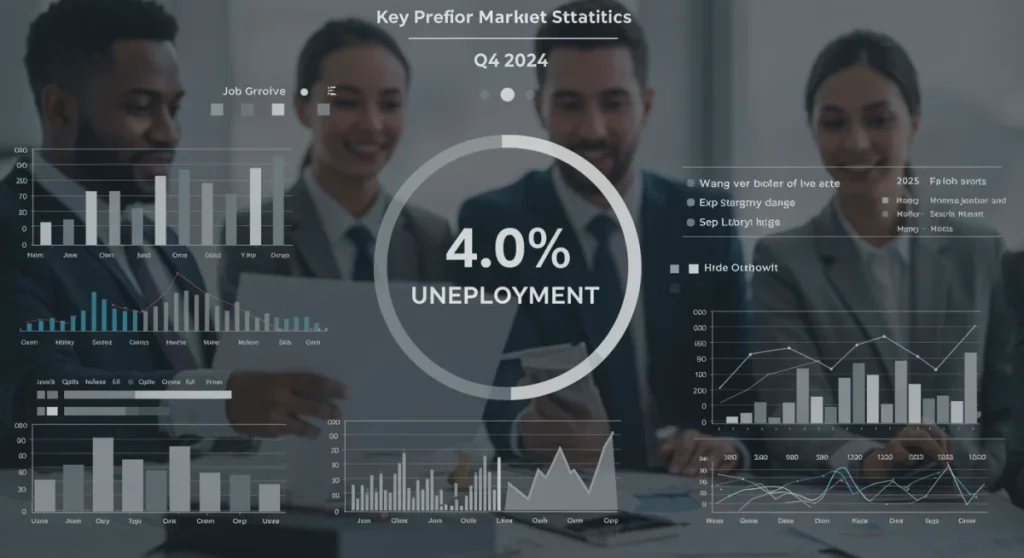BLS Q4 2024: 4.0% Unemployment & 2025 Hiring Outlook

The Bureau of Labor Statistics (BLS) Q4 2024 report indicates a 4.0% unemployment rate, suggesting a steady labor market that will influence hiring and economic forecasts for 2025 across the United States.
The latest Labor Market Update: New BLS Data Shows 4.0% Unemployment Rate for Q4 2024 – What it Means for Hiring in 2025 provides a crucial snapshot of the current economic landscape. This figure isn’t just a number; it’s a barometer for future hiring trends, wage growth, and overall economic stability. Understanding its nuances is vital for businesses and job seekers alike as we move into the new year.
Understanding the 4.0% Unemployment Rate
The Bureau of Labor Statistics (BLS) recently released its data for the fourth quarter of 2024, revealing a national unemployment rate of 4.0%. This figure is a critical indicator of the health and direction of the United States labor market. While a 4.0% rate is generally considered healthy, its implications are complex and far-reaching, influencing everything from consumer spending to corporate expansion plans.
To fully grasp the significance of this percentage, it’s important to consider it within historical context and against current economic conditions. A rate of 4.0% suggests that the economy is operating near full employment, meaning most individuals who want to work can find jobs. However, this doesn’t tell the whole story; underlying factors such as labor force participation, discouraged workers, and underemployment also play crucial roles in painting a complete picture of the market’s vitality.
Historical Context and Economic Benchmarks
Looking back at previous economic cycles helps us benchmark the current 4.0% unemployment rate. Periods of robust economic growth often see unemployment dip below this level, while recessions naturally push it much higher. This current rate, therefore, positions the US economy in a relatively stable yet watchful state, prompting analysis of its sustainability.
- Pre-pandemic levels: Comparing to the pre-2020 era, a 4.0% rate aligns with a strong job market.
- Recessionary highs: Significantly lower than the peaks observed during economic downturns.
- Federal Reserve targets: Often within the range considered acceptable for monetary policy stability.
The stability reflected in this number can foster confidence among businesses, potentially leading to increased investment and expansion. For individuals, it implies a more competitive job market where skills and experience remain highly valued. However, it also signals potential challenges for employers seeking to fill specialized roles, as the pool of available talent may be tighter than in periods of higher unemployment.
Sectoral Deep Dive: Where Jobs Are and Aren’t
While the aggregate 4.0% unemployment rate offers a broad view, a closer look at specific sectors reveals a more nuanced reality of the labor market. Certain industries are experiencing robust growth and demand for talent, while others face stagnation or contraction. This disparity is crucial for understanding where hiring efforts will concentrate in 2025.
High-growth sectors often include technology, healthcare, and renewable energy, driven by innovation, demographic shifts, and policy initiatives. Conversely, traditional manufacturing, retail (due to e-commerce shifts), and some administrative roles might see slower growth or even declines. This uneven distribution means that while overall unemployment is low, specific skill sets and geographic locations will experience vastly different market conditions.
Growth Engines: Technology and Healthcare
The technology sector continues its relentless expansion, fueled by advancements in AI, data science, and cloud computing. Demand for software engineers, data analysts, and cybersecurity specialists remains exceptionally high. Healthcare, similarly, is experiencing consistent growth due to an aging population and ongoing medical innovations, creating numerous opportunities for nurses, doctors, and allied health professionals.
- Technology: Strong demand for AI specialists, software developers, and cloud architects.
- Healthcare: Critical need for registered nurses, physicians, and medical technicians.
- Renewable energy: Emerging roles in solar installation, wind turbine maintenance, and energy efficiency.
These sectors not only offer abundant job opportunities but often come with competitive compensation and benefits, attracting a significant portion of the skilled workforce. Understanding these hotbeds of employment is key for both job seekers looking to upskill and employers planning their talent acquisition strategies for the coming year.
Wage Growth and Inflationary Pressures
The 4.0% unemployment rate often correlates with steady wage growth, as a tighter labor market typically empowers workers to command higher salaries. However, this positive development must be weighed against prevailing inflationary pressures. If wage increases merely keep pace with or fall behind the cost of living, the real purchasing power of workers may not improve significantly.
BLS data also monitors average hourly earnings, providing insights into whether wage growth is sustainable and broad-based across different industries and demographics. A balanced approach to wage increases is vital to prevent an inflationary spiral, where higher wages lead to increased prices, which in turn fuel demands for even higher wages. This delicate equilibrium is a major focus for economic policymakers.
The Tug-of-War: Wages vs. Inflation
Many economists are closely watching the interaction between wage growth and inflation. While workers appreciate higher pay, if it’s eroded by rising prices for goods and services, the economic benefit is diminished. This dynamic can influence consumer confidence and spending habits, which are critical components of economic growth.
- Real wage growth: Crucial for improving living standards, adjusting for inflation.
- Sectoral variations: Some industries may see more significant wage gains than others.
- Monetary policy impact: Federal Reserve decisions on interest rates are often influenced by this balance.
Employers, in turn, face the challenge of attracting and retaining talent with competitive compensation packages while managing their operational costs. The ability to navigate these pressures will be a defining characteristic of successful businesses in 2025, particularly in sectors with high demand for skilled labor.
Hiring Trends and Employer Strategies for 2025
With a 4.0% unemployment rate, the labor market heading into 2025 is expected to remain competitive for employers. Attracting and retaining top talent will require more than just competitive salaries; companies will need to focus on comprehensive benefits, flexible work arrangements, and a strong company culture. The shift towards remote and hybrid work models, accelerated by recent global events, is likely to continue evolving, influencing where and how people work.
Employers are increasingly investing in upskilling and reskilling programs for their existing workforce to address skill gaps and foster loyalty. This proactive approach not only helps fill critical roles but also enhances employee satisfaction and reduces turnover. Furthermore, diversity, equity, and inclusion (DEI) initiatives are becoming integral to hiring strategies, as companies recognize the value of varied perspectives and experiences.
Adapting to a Candidate-Driven Market
The sustained low unemployment rate suggests a market where candidates often have the upper hand. This necessitates a more strategic and empathetic approach from employers throughout the recruitment process. Organizations must actively market their employer brand and communicate their value proposition effectively to stand out.
- Flexible work options: Offering remote or hybrid models is a major draw.
- Holistic benefits: Beyond salary, focus on health, wellness, and professional development.
- Culture and values: Highlighting a positive work environment and shared purpose.
Recruitment strategies will need to evolve, leveraging advanced analytics and AI tools to identify and engage potential candidates more efficiently. Building strong talent pipelines and maintaining relationships with prospective hires will be paramount in securing the workforce needed for growth in the coming year.
Demographic Shifts and Labor Force Participation
The overall unemployment rate of 4.0% also reflects ongoing demographic shifts within the United States. An aging population means a growing number of retirements, potentially tightening the labor supply in certain sectors. Concurrently, younger generations are entering the workforce with different expectations regarding work-life balance, career progression, and social impact.
Labor force participation rates, which measure the proportion of the working-age population that is either employed or actively looking for work, provide another layer of insight. Fluctuations in this rate can indicate whether potential workers are being drawn into the market or are remaining on the sidelines. Understanding these trends is crucial for forecasting the long-term health and capacity of the labor market.
Generational Dynamics in the Workforce
The interplay between different generations in the workforce presents both opportunities and challenges. Experienced workers bring institutional knowledge, while newer entrants often bring fresh perspectives and digital fluency. Bridging these generational gaps through mentorship and inclusive policies can foster a more dynamic and effective workplace.
- Aging workforce: Impact on skilled trades and experienced leadership roles.
- Gen Z and Millennials: Emphasis on purpose, flexibility, and technological integration.
- Immigration’s role: Potential to replenish labor supply and diversify skill sets.
Policies that support workforce development, including vocational training and educational programs, will be vital in ensuring that the US labor force remains adaptable and competitive. Addressing these demographic realities will be key to sustaining economic growth and maintaining a healthy unemployment rate in the future.
Policy Implications and Economic Outlook for 2025
The 4.0% unemployment rate for Q4 2024 will undoubtedly influence policy decisions and shape the economic outlook for 2025. Federal Reserve actions, fiscal policies, and legislative initiatives will all be considered through the lens of maintaining labor market stability and fostering sustainable growth. Policymakers will be balancing the need to control inflation with the desire to support job creation and economic expansion.
Potential policy responses could include adjustments to interest rates, targeted investments in infrastructure or emerging industries, and reforms to education and training programs. The goal is to create an environment where businesses can thrive and individuals can find meaningful employment, contributing to overall prosperity. The ongoing interplay between global economic conditions and domestic policy will also be a significant factor.
Governmental Responses and Future Projections
Governmental bodies and economic institutions will be closely analyzing the BLS data to inform their strategies for the year ahead. The stability of the labor market provides a foundation for cautious optimism, but vigilance against potential headwinds, both domestic and international, remains paramount. Projections for 2025 will consider various scenarios, from continued steady growth to potential slowdowns.
- Monetary policy: Federal Reserve’s stance on interest rates and quantitative easing.
- Fiscal policy: Government spending, taxation, and budget decisions.
- Trade relations: Impact of international agreements and disputes on domestic industries.
Ultimately, the 4.0% unemployment rate is a strong indicator of a resilient US economy, but its future trajectory hinges on a complex interplay of internal dynamics and external forces. Thoughtful policy and adaptive business strategies will be essential in navigating the opportunities and challenges that 2025 will bring to the labor market.

| Key Aspect | Brief Description |
|---|---|
| Unemployment Rate (Q4 2024) | The national unemployment rate stands at 4.0%, indicating a tight and stable labor market. |
| Hiring Outlook 2025 | Employers face continued competition for talent, requiring strategic recruitment and retention efforts. |
| Key Growth Sectors | Technology, healthcare, and renewable energy are expected to drive job creation and demand. |
| Wage & Inflation Dynamics | Wage growth is steady, but its real value is influenced by ongoing inflationary pressures. |
Frequently Asked Questions About the Q4 2024 Labor Market
A 4.0% unemployment rate generally indicates a healthy and nearly full-employment economy. It suggests that most people who want to work can find jobs, fostering consumer confidence and potentially leading to moderate wage growth and economic stability.
Based on current trends, technology, healthcare, and renewable energy sectors are projected to experience significant hiring growth in 2025. These industries are driven by innovation, demographic shifts, and increasing demand for specialized skills and services.
A low unemployment rate typically creates a tighter labor market, giving workers more leverage to negotiate higher wages. This can lead to steady wage growth, though its real impact on purchasing power depends on whether it outpaces inflation.
Employers in 2025 will likely face challenges in attracting and retaining talent due to increased competition. They will need to offer competitive compensation, comprehensive benefits, flexible work options, and strong company cultures to secure skilled workers.
Demographic shifts, such as an aging population leading to more retirements and younger generations entering with new expectations, significantly influence labor supply and demand. These changes require adaptive workforce development and recruitment strategies.
Conclusion
The Labor Market Update: New BLS Data Shows 4.0% Unemployment Rate for Q4 2024 – What it Means for Hiring in 2025 paints a picture of a resilient yet dynamic economic environment. While the 4.0% unemployment rate signifies a robust labor market, its implications extend beyond a single number, influencing sectoral growth, wage dynamics, and employer strategies. As we transition into 2025, businesses and job seekers alike will need to remain agile, adapting to evolving demands and capitalizing on emerging opportunities to ensure continued prosperity and stability in the American workforce.






